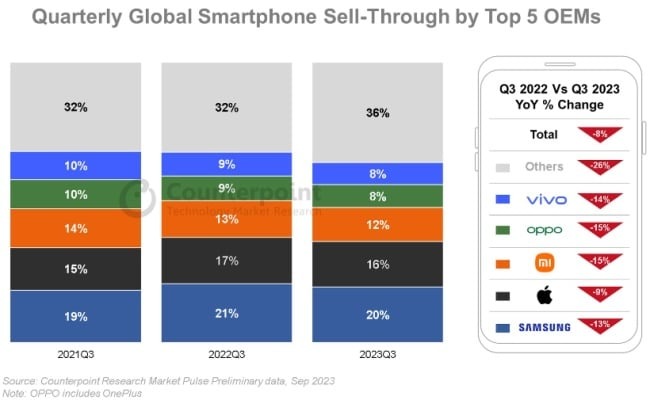Samsung leads the global smartphone market with a 20% market share in Q3/2023 even though the market is going down.

Samsung once again won the global smartphone market, ranking number one in shipments. The Korean company beat Apple, Xiaomi, OPPO, Vivo, and other smartphone brands in the contract market. According to a report from Counterpoint Research, the global smartphone market decreased by 8% points in Q3.2023 compared to Q3.2022.
This year has been a tough one for all smartphone brands, including Apple and Samsung. However, thanks to higher profits, they are in a better position than most other Chinese smartphone brands. Samsung had a 20% share of the global smartphone market in Q3.2023, but its shipments were 13% lower than the previous year. Samsung launched its fifth-generation foldable phones, the Galaxy Z Flip5 and Galaxy Z Fold5, during the quarter and improved sales of the Z Flip device compared to its predecessor thanks to larger screens and performance. improved. The Galaxy Z Fold5 had mixed results as it didn't bring any major improvements.

Apple was the second-largest smartphone brand in the third quarter of 2023, with shipments also down 9% year-over-year. This could be because everyone was waiting for the launch of the new iPhone 15 series, but that could also have been true last year. According to the report, Apple accounted for 16% of the market share in the third quarter of this year.
Xiaomi, with a market share of 12%, ranks third globally. The company's smartphone sales decreased by 15% compared to the previous year. OPPO and Vivo each account for 8% of the global smartphone market share. While Vivo's phone sales decreased by 14%, OPPO's sales decreased by 15% compared to Q3 2022. Huawei, Honor, and Tecno (Transsion) were the only smartphone brands to see their sales improved compared to the same period last year.
Over the past year, the smartphone market has gone through difficult times. Almost all smartphone brands have seen their sales and shipments decline, and during these testing times, Samsung has been successful in increasing its mid-range and high-end smartphone sales. by selling more Galaxy S and Galaxy Z phones. Despite lower sales, selling more high-end devices resulted in improved profits. As a result, the company was able to offset losses from the semiconductor chip segment by boosting the profits of its smartphone and display panel divisions.
 SamFw
SamFw

